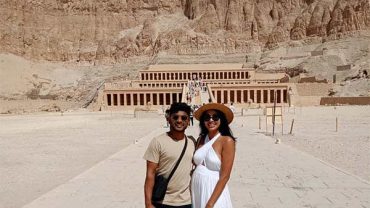The Mosque of Amr ibn al-As stands as a testament to the early foundations of Islamic architecture, embodying a rich history that dates back to the 7th century. Named after Amr ibn al-As, a companion of Prophet Muhammad and the conqueror of Egypt, this mosque is a revered symbol of Islam’s expansion and cultural influence. As we delve into the historical significance, architectural marvels, and enduring legacy of the Mosque of Amr ibn al-As, we gain a deeper understanding of its role in shaping the Islamic world.
Historical Background
The mosque’s history is intertwined with the early conquests of Islam. Amr ibn al-As, a trusted companion of Prophet Muhammad, led the Muslim forces into Egypt in 639 AD. Following the successful conquest, Amr ibn al-As, recognizing the need for a central place of worship, ordered the construction of the mosque that bears his name. The Mosque of Amr ibn al-As, completed in 642 AD, is regarded as the first mosque built on the African continent, marking a pivotal moment in the spread of Islam.
This historical landmark not only served as a religious center but also played a crucial role in the social and political fabric of early Islamic Egypt. It was a hub for community gatherings, scholarly pursuits, and administrative functions, solidifying its place as a cornerstone of Islamic civilization.
Architectural Splendor
The Mosque of Amr ibn al-As reflects the architectural ingenuity of its time. While the original structure has undergone several renovations and expansions over the centuries, it retains its essence as an exemplary piece of early Islamic architecture. The mosque initially consisted of simple mudbrick walls and a palm-frond roof, embodying the modesty and humility advocated by Islam.
Subsequent renovations introduced more sophisticated elements, such as the iconic minaret that stands tall against the Cairo skyline. The mosque’s courtyard, with its open space and ablution fountains, exemplifies the practicality and functionality inherent in Islamic architectural design. Intricate geometric patterns and Quranic inscriptions adorn the interior, showcasing the aesthetic beauty that accompanies religious significance.
Cultural and Educational Hub
Beyond its religious functions, the Mosque of Amr ibn al-As emerged as a cultural and educational hub during the Islamic Golden Age. Scholars and intellectuals gathered within its walls, engaging in discussions on theology, science, and philosophy. The mosque housed a significant library, contributing to the preservation and dissemination of knowledge.
The mosque’s role as an educational institution extended to the development of Islamic jurisprudence and the establishment of a vibrant intellectual community. Its influence on the cultural and educational landscape of medieval Cairo is a testament to the mosque’s enduring impact on shaping Islamic thought.
Enduring Legacy
The Mosque of Amr ibn al-As stands today as a living testament to the resilience of Islamic heritage. Despite the passage of centuries and numerous renovations, the mosque continues to be a place of worship, reflection, and historical reverence. Pilgrims and visitors from around the world are drawn to its hallowed grounds, seeking not only spiritual solace but also a connection to the roots of Islamic civilization.
Socioeconomic Impact
The presence of the Mosque of Sultan Nasir Mohammed contributes significantly to the local economy. The influx of tourists and scholars sustains a thriving ecosystem of businesses, from local markets and restaurants to artisans who create and sell traditional crafts. The mosque serves as a catalyst for economic growth, providing employment opportunities and fostering entrepreneurship within the community.
Moreover, the mosque engages in community outreach programs, addressing social issues and contributing to local development projects. This multi-faceted impact underscores the mosque’s role as not just a religious and cultural landmark but also a dynamic force for positive change within the community.
Future Prospects
As we look to the future, the Mosque of Sultan Nasir Mohammed stands poised to continue its legacy as a cultural and spiritual touchstone. Ongoing efforts to integrate modern technology for conservation, educational outreach, and visitor engagement ensure that the mosque remains relevant in the ever-evolving landscape of the 21st century.
The mosque’s leadership and the broader community recognize the responsibility of preserving and promoting this invaluable heritage. By embracing the challenges of the present while respecting the traditions of the past, the Mosque of Sultan Nasir Mohammed is positioned to inspire generations to come, fostering a sense of connection and continuity in an ever-changing world.
Preservation Challenges and Restoration Efforts
While the Mosque of Amr ibn al-As has weathered the sands of time, it has not been without its challenges. The wear and tear of centuries, along with environmental factors, posed threats to the structural integrity of this historical site. In response, various restoration efforts have been undertaken to ensure the preservation of its unique architectural features.
Modern conservation techniques, guided by both historical accuracy and technological advancements, have played a crucial role in safeguarding the mosque’s heritage. These restoration endeavors aim not only to maintain the physical structure but also to revive its cultural and historical significance. Through meticulous research and collaboration between historians, architects, and preservationists, the mosque continues to stand as a living relic of Islamic civilization.
Interfaith Dialogue and Cultural Exchange
The Mosque of Amr ibn al-As has become a symbol of interfaith dialogue and cultural exchange in the contemporary world. As one of the oldest mosques in Africa, it attracts visitors from diverse backgrounds, fostering an environment where people of different faiths and cultures can come together to appreciate and learn from each other. The mosque’s historical significance transcends religious boundaries, serving as a bridge between civilizations and a reminder of the shared cultural heritage of humanity.
In a global context, initiatives to promote the understanding of Islamic art and architecture have elevated the Mosque of Amr ibn al-As to a symbol of cultural diplomacy. Exhibitions, educational programs, and guided tours contribute to a more profound appreciation of Islamic history and its contributions to the world.
Tourism and Economic Impact
As the Mosque of Amr ibn al-As attracts an increasing number of tourists, it has become a focal point for cultural and heritage tourism. The influx of visitors contributes to the local economy, providing economic opportunities for the surrounding community. Souvenir shops, local markets, and hospitality services have flourished, creating a sustainable economic ecosystem around this historical landmark.
The economic impact extends beyond the immediate vicinity, positively influencing the tourism sector in the broader region. The mosque’s prominence as a historical and cultural attraction adds to the allure of Egypt as a destination for travelers seeking a deeper understanding of its rich heritage.




Comment (0)